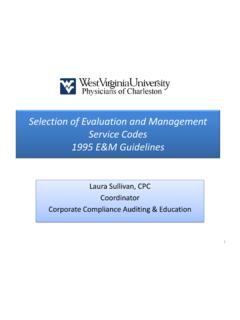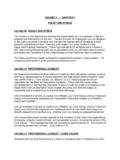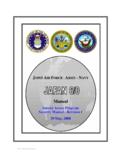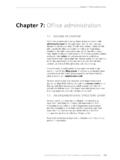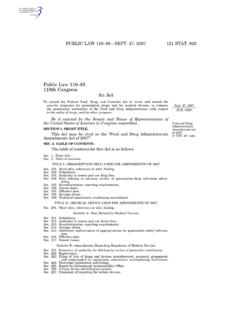Transcription of Section: Chapter: Administration Policy: Best …
1 policy /PROCEDURE NO.: B-27 Effective date: August 23, 2012 Date(s) of revision: Policies and Procedures: Templates, SmartText, SmartPhrases and Macros in the Epic System section : Compliance chapter : Administration policy : best Practice Recommendations for the Use of Templates, SmartText, SmartPhrases and Macros in the Epic System I. PURPOSE To establish a policy which provides guidance and best practices relating to the utilization of electronic documentation features within the Epic system, such as templates, SmartText, SmartPhrases and macros.
2 This guidance should be construed as applying to any feature within the Epic system which allows a provider to document a series of typed characters or other keystrokes in order to quickly document portions of a medical note. II. APPLICABILITY This policy applies to all WVUPC providers who enter documentation into a WVUPC clinical record within the Epic system. III. BACKROUND 1. Palmetto GBA and CMS recognize that a provider s documentation may be dictated and transcribed, typed, handwritten or computer generated. In that regard, providers, including teaching physicians, may utilize macros as part of their documentation in an electronic health record.
3 As defined by CMS, macros are commands in computer or dictation applications that automatically generate predetermined text that is not edited by the user. 2. Palmetto GBA and CMS permit teaching physicians to utilize a macro as part of their required personal documentation if the teaching physician personally adds it in a secured or password protected system. In addition to the teaching physician s macro, either the resident or the teaching physician must provide customized information that is sufficient to support a medical necessity determination. 3. The provider/teaching physician s note in the electronic medical record must sufficiently describe the specific services furnished to the specific patient on the specific date of service.
4 If both the resident and the teaching physician use only macros, this is considered insufficient documentation. policy /PROCEDURE NO.: B-27 Effective date: August 23, 2012 Date(s) of revision: 4. Palmetto GBA and CMS also prohibit the practice of medical record cloning. When documentation is worded exactly like previous entries within a medical record, the documentation is referred to by CMS as cloned documentation. 5. Whether cloned documentation is handwritten, the result of pre-printed templates, or the use of electronic health records, cloning of documentation will be considered misrepresentation of the medical necessity requirement for coverage of services.
5 Identification of this type of documentation will lead to denial of services for lack of medical necessity and recoupment of all overpayments made. IV. policy /PROCEDURE 1. Providers must exercise caution when utilizing electronic documentation features within Epic such as templates, SmartText, SmartPhrases and macros. Although such features are beneficial in helping to fulfill documentation requirements, the use of such features could, if used inappropriately, result in over or under-documentation of services. 2. Providers should remember that, regardless of the length or completeness of any note, the final level of service for billing purposes must be based upon the medical necessity of the service actually rendered.
6 3. Providers should not feel compelled to document every single element within a template, macro, SmartPhrase, or SmartText for every patient on every visit. Instead, they should only document those elements pertinent to the patient for that specific visit. 4. Although the use of provider built macros, SmartText and SmartPhrases within Epic can facilitate documentation, care must be exercised so as not to run afoul of the prohibited practice of cloned documentation or cookie cutter notes. 5. Each provider is responsible for the careful review and editing of any re-used documentation such as macros, SmartText or SmartPhrases.
7 Failure to do so can result in documentation errors, including contradictions and inaccuracies within notes. 6. Providers must accurately document what was medically necessary and pertinent on each patient visit, and edit his/her documentation in order to reflect the true, medically necessary service actually provided. 7. Providers are encouraged to work closely with their department s coding and billing staff, and with WVUPC s Epic trainers, and Compliance and Health Information Management Departments in the development of appropriate macros and SmartPhrases/SmartText in order to ensure that all applicable documentation requirements are met.
8 policy /PROCEDURE NO.: B-27 Effective date: August 23, 2012 Date(s) of revision: V. Amendment or Termination of this policy This policy may be amended or terminated at any time. VI. References CMS Medicare Learning Network Fact Sheet: Guidelines for Teaching Physicians, Interns and Residents, ICN 006347, December 2011 Palmetto GBA (J11, Part B), Medical Record Cloning, 12/06/2011 AAMC Compliance Officers Forum, Appropriate Documentation in an HER: Use of Information That is Not Generated During the Encounter for Which the Claim is Submitted: Copying/Importing/Scripts/Templates, 7/11/2011



